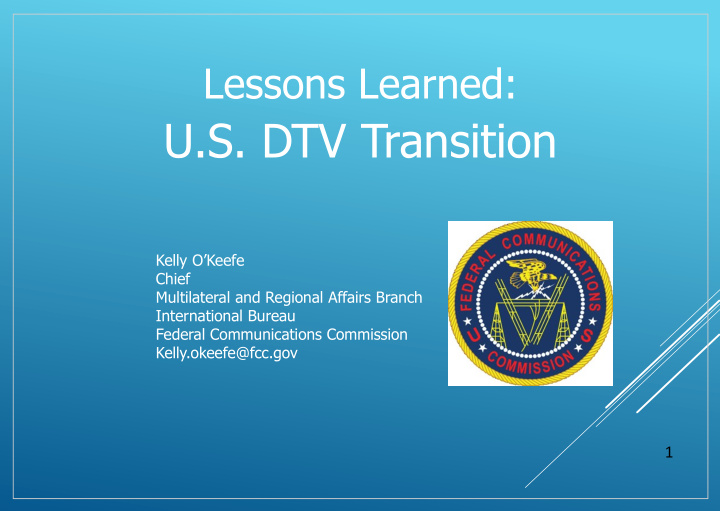



Lessons Learned: U.S. DTV Transition Kelly O’Keefe Chief Multilateral and Regional Affairs Branch International Bureau Federal Communications Commission Kelly.okeefe@fcc.gov 1
U.S. Goals • Improve broadcast sound and picture • High Definition • 5.1 Surround Sound • Accommodate new services • Program guides • Additional TV channels • Mobile • Recover large amount of high-quality spectrum for mobile services 2
U.S. TIMELINE Early 1990s: Industry begins competition for U.S. digital standard 1996: “Grand Alliance” adopts ATSC as the DTV standard 1996-97: Congress grants each broadcaster an additional temporary 6 MHz channel for DTV transition and establishes a transition end date 1997: FCC adopts service rules and creates Table of Allotments for additional channels 1998: First DTV station on air 3
U.S. TIMELINE (CONT.) 2002: Manufacturers required to include digital tuner in TV sets 2004: Deadline set for stations to broadcast at full service, consumer education initiative begins 2006: Congress establishes “hard deadline” of February 17, 2009 and creates subsidy program for DTV converter boxes 2007-08: FCC finalizes DTV Table of Allotments and procedures for construction applications 2008-09: Subsidy coupons issued for DTV converter boxes; focus begins on consumer outreach and education June 12, 2009: Digital switchover 2015: Digital conversion deadline for low-power TV, class A, translator stations 4
700 MHZ BAND PLAN � Ensures Public Safety � Large Blocks of Spectrum • Up to 10 MHz wide available for commercial use 5
TRANSITION SUCCESSFUL Transition completed on June 12, 2009! � Relatively few problems on and after the transition deadline � Many post-transition reception problems were resolved by consumers performing a “double rescan” on their converter box. � Other problems were resolved by consumers through “trial and error” relocation of indoor antennas or by upgrading their antennas. � UHF reception was as good or better than expected, and VHF reached viewers further out than UHF, as expected. 6
DOMESTIC OUTREACH EFFORTS FCC spent nearly $130 million NTIA spent $1.3 on consumer outreach billion for coupon • Consumer education (print, TV program and radio announcements) • Subsidy coupon was • One-on-one assistance with used to purchase a installation of converter boxes, digital-to-analog “boots on the ground” by FCC converter box staff • Two coupons per • Publications were developed in household English and Spanish & key • Worth $40 each publications were translated TV broadcasters into 29 languages spent $1.2 billion • FCC used existing toll-free call on outreach center. • Public service • http://www.DTV.gov announcements • Consumer 7 publications • Public appearances
DOMESTIC OUTREACH EFFORTS 8
CROSS-BORDER COORDINATION DTV band plans and digital dividend spectrum must be coordinated with neighbors – Harmonize if possible! – Start early! – Bilateral coordination requires taking into account: • Different transition timelines • Development of channel plans to permit each country to transition at its own pace • Potentially different technologies 9
DTV Transition - Lessons Learned What Worked? Outreach: – Industry coordination with broadcasters, as well as manufacturers, retailers – early and ongoing, national and local – Federal government coordination – NTIA, other agencies that have regular contact with consumers (e.g., posters in post offices) – Local governments – challenge to get their attention early but establishing local relationships was key – Local organizations that focus on elderly, low income, non-English- speaking – Awareness of transition was very high 10
DTV Transition - Lessons Learned What Worked? Consumer Assistance: – Local walk-in centers, including at retailers and local stations, for information and to sign up for coupons – FCC-trained Call Centers available 24/7 on toll-free number with up-to-date referral information – Demonstrations of how to set up equipment at workshops – Contractors to help consumers in their homes – Post-transition work with our partners to develop new antenna guides based on post-transition experience posted on http://www.DTV.gov 11
DTV Transition - Lessons Learned What Worked? Technical Considerations: – We set a hard deadline – But we delayed our deadline when it was clear we were not ready • Delay the deadline if you need to in order to get it right, but don’t delay too long as you might lose momentum – Post-transition work with our partners to develop new antenna guides based on post-transition experience – We conducted early test transitions in a few markets 12
DTV Transition - Lessons Learned What Could Have Gone Better? \ – Earlier and more transition test markets might have helped in the final transition planning – Simplified installations and antenna adjustments would have eased the burden on elderly and those uncomfortable with technology – Ensure people had the appropriate antennas – Understand differences among equipment, both TVs and boxes, in order to explain how to solve problems (e.g., double rescan) – Managing expectations of those who had poor analog but now have no digital reception 13 • Coverage footprint got smaller from transitioning to digital, and some viewers on the edge of coverage lost the station signal
Other Considerations • Funding for outreach and contracts (e.g., call center and in- person assistance) should be anticipated and budgeted early in the process. • Educational materials and training should be developed well in advance and updated as test market experience identifies the need for revisions. • Coordination with neighboring countries and obtaining bilateral agreements should be scheduled early in the process to address technical issues and identify mutual sharing solutions. • Technical issues with lower VHF channels (poor reception) 14
Thank You! Kelly O’Keefe Chief Multilateral and Regional Affairs Branch International Bureau, FCC Kelly.okeefe@fcc.gov 15
Recommend
More recommend